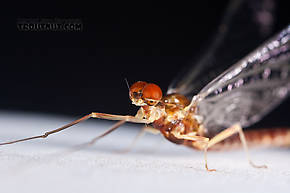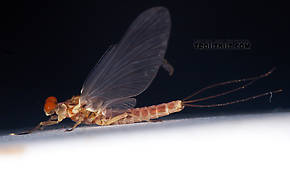Blog & Latest Updates
Fly Fishing Articles
Insects by Common Name


Mayfly Species Ephemerella aurivillii
Taxonomic Navigation -?-
Kingdom
Animalia (Animals)
» Phylum
Arthropoda (Arthropods)
» Class
Insecta (Insects)
» Order
Ephemeroptera (Mayflies)
» Species aurivillii
Where & When
This species was first described in Europe, and has also been found in Asia and North America. I have collected them in Alaska and New York, and probably Wisconsin, although the ID on the Wisconsin specimens is less certain.
I found ready-to-hatch, definitive Ephemerella aurivillii nymphs near Fairbanks, Alaska, in mid-July. However, because this species is found across such a large geographic range, the emergence timing probably varies widely. They may go unnoticed in the East due to overlaps in timing with more abundant Ephemerella species.
Pictures of 21 Mayfly Specimens in the Species Ephemerella aurivillii:
Male Ephemerella aurivillii Mayfly Spinner View 15 PicturesThis spinner molted from a dun after being photographed, and the dun form is listed here as a separate specimen. I've rarely found a more cooperative and photogenic mayfly.
View 15 PicturesThis spinner molted from a dun after being photographed, and the dun form is listed here as a separate specimen. I've rarely found a more cooperative and photogenic mayfly.
 View 15 PicturesThis spinner molted from a dun after being photographed, and the dun form is listed here as a separate specimen. I've rarely found a more cooperative and photogenic mayfly.
View 15 PicturesThis spinner molted from a dun after being photographed, and the dun form is listed here as a separate specimen. I've rarely found a more cooperative and photogenic mayfly.Male Ephemerella aurivillii Mayfly Dun View 14 PicturesThis is the most widespread species of Ephemerella, and also the most abundant in some places, but nobody I've talked to seemed to know what its duns looked like, and there were no pictures of its duns online or in any angling books. That mystery is solved with this male dun, which hatched from a definitively identified nymph.
View 14 PicturesThis is the most widespread species of Ephemerella, and also the most abundant in some places, but nobody I've talked to seemed to know what its duns looked like, and there were no pictures of its duns online or in any angling books. That mystery is solved with this male dun, which hatched from a definitively identified nymph.
 View 14 PicturesThis is the most widespread species of Ephemerella, and also the most abundant in some places, but nobody I've talked to seemed to know what its duns looked like, and there were no pictures of its duns online or in any angling books. That mystery is solved with this male dun, which hatched from a definitively identified nymph.
View 14 PicturesThis is the most widespread species of Ephemerella, and also the most abundant in some places, but nobody I've talked to seemed to know what its duns looked like, and there were no pictures of its duns online or in any angling books. That mystery is solved with this male dun, which hatched from a definitively identified nymph.Ephemerella aurivillii Mayfly Nymph View 7 Pictures
View 7 Pictures
 View 7 Pictures
View 7 PicturesCollected May 10, 2008 from the Chena River in Alaska
Added to Troutnut.com by Troutnut on April 20, 2011
Added to Troutnut.com by Troutnut on April 20, 2011
Your Thoughts On Ephemerella aurivillii:
Top 10 Fly Hatches
Top Gift Shop Designs
Eat mayflies.
Top Insect Specimens
Miscellaneous Sites
Troutnut.com is copyright © 2004-2024 Jason
Neuswanger (email Jason). See my FAQ for information about use of my images.
 privacy policy
privacy policy
